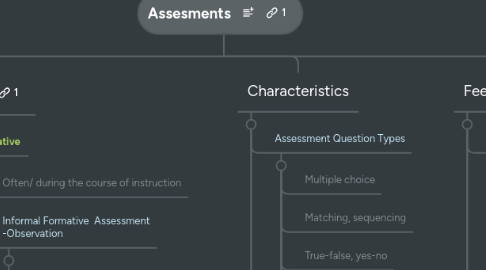
1. Types
1.1. Formative
1.1.1. Often/ during the course of instruction
1.1.2. Informal Formative Assessment -Observation
1.1.2.1. Informal observations Questioning Spontaneous Instructional adjustments Immediate Feedback
1.1.3. Formal Formative Assessment -Quizzes
1.1.3.1. Structured exercises Pretests Homework In class assignments Quizzes and Unit tests Classroom Response Systems
1.2. Interim/benchmarked
1.2.1. Pre-determine points of time usually every six weeks or chapter test.
1.2.2. Formal style using projects, written assignments, and tests such as benchmarks
1.2.3. Low-level/ little or no student feedback
1.2.4. Feedback about student work, not the student
1.3. Summative
1.3.1. End of unit and/or end of year
1.3.2. Preparing students
1.3.2.1. Item type and format
1.3.2.2. Assessment anxiety
1.3.3. Conducting Summative Assessments
1.3.3.1. When should they be scheduled ?
1.3.3.2. When should they be created?
1.3.4. Creating Summative Assessments
1.3.4.1. Assessment Directions
1.3.4.2. Arrange Items
1.3.4.3. Physical Layout
2. Feedback
2.1. Types of Feedback
2.1.1. Goal-directed
2.1.2. Scaffolded
2.1.3. Self-Referenced
2.1.4. Standards-Referenced
2.1.5. Norm-referenced
2.2. The nature of the feedback
2.2.1. Amount
2.2.2. Timing
2.2.3. Mode
2.2.4. Audience
2.2.5. Type of task
2.3. Differentiated Formative Feedback
2.3.1. Learner Level of Ability
2.3.2. Grade Level
2.3.3. Subject
2.4. Effective Feedback
2.4.1. Relates performance to standards
2.4.2. Relates performance to strategies
2.4.3. Indicates progress
2.4.4. Indicates corrective action
2.4.5. Specific
2.4.6. Focuses on errors
2.4.7. Focuses on effort attributions
3. Characteristics
3.1. Assessment Question Types
3.1.1. Multiple choice
3.1.2. Matching, sequencing
3.1.3. True-false, yes-no
3.1.4. Factual short answer, fill-ins
3.1.5. Higher-order shot answer
3.1.6. Short or long essay
3.1.7. Reliability and Validity
3.2. Delivery Types
3.2.1. Paper and pencil
3.2.2. Online
3.2.3. Computer adaptive tes
3.3. Scoring Types
3.3.1. Human scoring
3.3.2. Distributed scoring
3.3.3. Automated scoring
3.3.4. Rubric
3.3.5. Checklists
